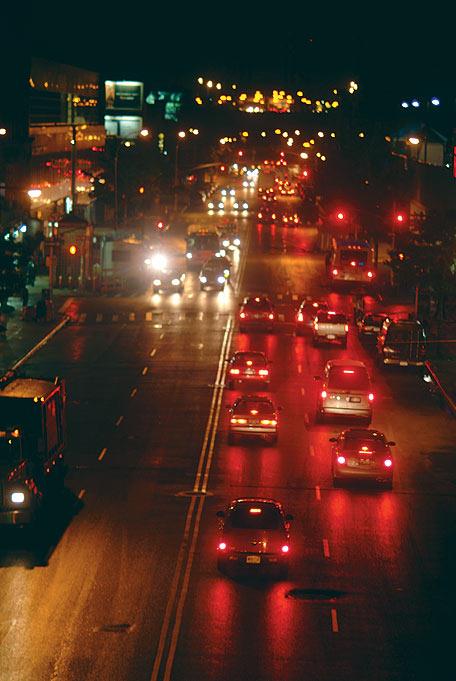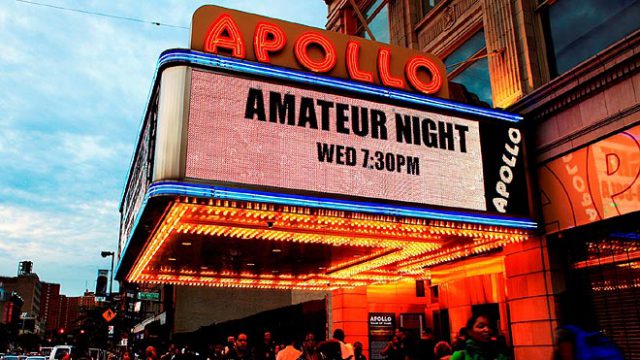Shortly after I moved to a flat on 125th Street in the autumn of 1999, I came
I liked the serendipity of the discovery, of finding an Indian novel that referred to a character moving to my present location even as I worked on my own novel and tried to imagine and remember India’s Northeast while looking out at the concrete and brick of Harlem. That there might also be something of India in what I was looking at came to me from a different source, a short story by James Baldwin called ‘Sonny’s Blues’. Sonny is in Harlem after a long stint in prison when his brother asks him if he remembers his childhood dreams about going to India, about his dreams of holy men smeared in ash or walking on coals on the road to wisdom. These are Orientalist images, but Sonny himself has been struggling to get out of constricting images of Harlem and the black man. The dream of India as a fantasy of escape becomes an image of homecoming when Sonny gestures at the streets of Harlem and says, “This place is Indian enough for me.”
Was it Indian enough for me? In some ways, I had been happy to move to Harlem. I wanted to experience New York in all its promiscuous glory, and I was afraid of coming back to India with a truncated version of the city that would include Columbia, Central Park, the Statue of Liberty and little else. After encountering some of Manhattan’s supercilious rental agencies, I was also grateful to the black owner for not caring too much about my lack of a credit history and felt lucky to have found a place within easy walking distance of Columbia University.
Technically, the Columbia University area itself is a part of Harlem, which runs north of 110th Street, south of 151st Street and west of Fifth Avenue. In that apartment with the strangely angled walls and fake parquet floor, I remember watching the 1972 movie Across 110th Street, bemused at the dangers evoked in the title. In the three decades since the making of the film, the fifteen blocks from 110th Street to 125th had become a genteel, affluent neighbourhood. If there were elements of Harlem’s history still embedded in the area, it was in Riverside Church and the speakers still invited there. Martin Luther King Jr had given his ‘Beyond Vietnam’ speech at Riverside Church, Arundhati Roy recently addressed a packed audience there and, one afternoon a few years ago, there was a line of people stretching all the way down to Broadway and 125th waiting to hear Fidel Castro.
The bell tower of Riverside Church is still one of the best places to visit for a view of uptown Manhattan and Harlem. If one avoids the hours when the clanging bell deafens the tower, it is possible to look quietly down to a landscape changing slowly from the lush green of Riverside Park to stately Harlem brownstones as one’s gaze sweeps eastwards. What is visible only from street level, however, is that the border of Across 110th Street has moved up to 125th Street. I discovered small but important things by living there that I may not have known otherwise. The city didn’t bother to collect garbage regularly here, many of the grocery stores carried things of poor quality, the convenience stores shut early and the police precinct around the corner constantly sent out screaming emergency vehicles and prowl cars. Across my building, a ghettoblaster kept up a steady, throbbing beat of hip-hop late into the night, the music changing only on Saturdays into slow, romantic numbers that were both hopeful and hopelessly sad. One Sunday morning, there were policemen and narcotics agents swarming around the building across, apparently there to close the crackhouse of the Black Tops gang.
The gang members never bothered me, although one day two police cars pulled up to the corner of the street where I was standing and a couple of cops started asking questions. I answered their questions but they weren’t satisfied for a long time; I matched the description of someone making trouble at the check cashing centre, and it was a while before they went away to find someone else. Other encounters were more spontaneous, usually conversations with strangers who simply wanted to let the weight off their chest. Because the people who needed to talk were often recent migrants from the Caribbean or the American Deep South, I saw in these meetings something of the complex history of Harlem. During the time of the Harlem Renaissance in the 1920s, it had stood out as a welcoming place for blacks fleeing the poverty and racism of the heavily segregated South; the conversations showed that even now there were people making their hopeful way here.
Much of this has changed in the past few years, and 125th has now become the site of further gentrification as big chain stores take up retail space in the area. There is an Upper Manhattan Empowerment Zone intended to ‘revitalise’ Harlem, and Bill Clinton took an office on 125th Street some years ago in what was seen as a further sign of the improvement to come. I have my doubts about improvements that push out the poor and black people in a city that is increasingly weighted towards the wealthy, but I recently went for a long walk to see for myself how things were. I didn’t meet Bill Clinton during my walk, but I did run into Hillary.
The sidewalks on 125th get increasingly crowded with small vendors and pedestrians as you move eastwards. Incense sticks, paintings, stylised prints of jazz musicians and blues players and a long row of booksellers who put out collections that range from African-American kitsch to seriously political tracts. You can get a Cornel West reader or a collection of Mumia Abu-Jamal’s essays for $7, and there are always surprising finds such as Percival Everett’s fantastic novel Erasure. At Frederick Douglass Boulevard, I saw a small crowd and policemen in front of the Hue-Man Bookstore Café, and I drifted towards it. A scholarly-looking young man in dreadlocks was waiting with a book, and I asked him what was going on. “Book signing,” he said, showing me Hillary Clinton’s memoirs.
I hung on with the crowd, the policemen and the lone secret service agent in a black suit. Two black SUVs drew up. More secret service agents jumped off as if they had rehearsed by watching Hollywood movies carefully, but there was really no grave threat in the air. Senator Clinton was strikingly blonde, dressed in a pink suit, her makeup shining in the sun. There was little hauteur about her and the atmosphere was easy-going. She turned towards the television crew and then the other way as loud cheers went up. “Hillary for president,” someone there shouted, and I saw pride in the faces of the black women gathered there.
Then I started walking again. It’s easy to understand why the Clintons are popular in Harlem when one thinks of the great white totem president that came after, but Harlem has always been a place for liberal and radical politics. Castro, once again, was an honoured guest at the Theresa Hotel in the 1960s when a fancy midtown establishment refused to let him and the Cuban delegation stay. I passed one of the biggest army recruitment centres I had seen in Manhattan and, not too long after, I found myself reading a sign protesting the war and the occupation in Iraq at the Liberation Bookstore on 131st and Malcolm X Boulevard.
There were more tourists and young affluent whites in Harlem than I had seen before, and the gentrification of the area came in many forms. There was a tacky Disney store, a Starbucks, an H&M retail outlet and new restaurants on 125th Street. On a quiet side street, a row of boarded-up townhouses faced a building where Citibank had put up a pair of hoardings on fire escapes, and it was the perfect example of how old, long-time residents were likely to be pushed out as Big Business made its way in.
The presence of big business may create the right environment for tourists looking for a quick thrill, but Harlem is ultimately a combination of its people, politics, history and culture. The New York Public Library’s Schomburg Center on Malcolm X Boulevard and 135th Street is a useful place to get some sense of the history, although budget cuts mean that the centre is closed on Mondays. The Studio Museum in Harlem also runs interesting exhibits, including a series called Harlem Postcards, but it is really walking around with an open eye and open mind that reveals the place and allows something to surprise you. The Schomburg Center may be an impressive institution of state-sponsored culture, but what is equally striking is the graffiti above the playgrounds
opposite that says: “Harlem Plays the Best Ball in the Country.”
I found my own particular surprise at the tail end of my meandering walk when I turned towards 124th on Lenox Avenue. A high school run by Christian Brothers stood on the corner of the street, a quiet building from which young boys appeared in groups of three or four. The school was Rice High School, and 124th was called Blessed Edmund Rice Street. I knew who Edmund Rice was instantly, and the green street signboard with his name was like a letter with news of an old friend. Over twenty years ago, in a town on the other side of the world in north-eastern India, I had been asked to pray for Edmund Rice to be made a saint in the Roman Catholic church. I stopped praying altogether at some point, but I dimly remembered that Rice was an Irishman interested in the education of poor children. I had stopped believing in gods and saints and didn’t really care about his entry into the Catholic pantheon, but I felt happy to see the familiar name in what I thought was an unfamiliar corner. The adjective ‘blessed’ on the signboard told me that Rice had not made it to sainthood yet, and although all I heard was the sound of thumping feet and car horns and bouncing balls rather than prayers fluttering up to heaven, I hoped that he was very, very close.
The Information
Getting there
Continental Airlines is the only airline that has direct flights from Delhi to New York (but Newark airport, not JFK) from approx. Rs 61,000 return. Flight time is 14–15hrs.
Where to stay
You could stay elsewhere in NYC and make a day trip or two into Harlem. Or not. A small B&B-style guesthouse that offers charming accommodation in Harlem is Efuru Guest House(from $98; +1-212-9619855, efuru-nyc.com), with four rooms, with private baths and kitchens. Among the new hotels, the trendy Aloft Harlem merits checking out ($260; 7494000,starwoodhotels.com).
New York
USA
Leave a Reply
You must be logged in to post a comment.



